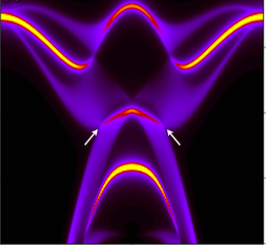
By Tien Nguyen, Department of Chemistry
Researchers at Princeton, Yale, and the University of Zurich have proposed a theory-based approach to characterize a class of metals that possess exotic electronic properties that could help scientists find other, similarly-endowed materials.
Published in the journal Physical Review X, the study described a new class of metals based on their symmetry and a mathematical classification known as a topological number, which is predictive of special electronic properties. Topological materials have drawn intense research interest since the early 2000s culminating in last year’s Nobel Prize in Physics awarded to three physicists, including F. Duncan Haldane, Princeton’s Eugene Higgins Professor of Physics, for theoretical discoveries in this area.
“Topological classification is a very general way of looking at the properties of materials,” said Lukas Muechler, a Princeton graduate student in the laboratory of Roberto Car, Princeton’s Ralph W. *31 Dornte Professor in Chemistry and lead author on the article.
A popular way of explaining this abstract mathematical classification involves breakfast items. In topological classification, donuts and coffee cups are equivalent because they both have one hole and can be smoothly deformed into one another. Meanwhile donuts cannot deform into muffins which makes them inequivalent. The number of holes is an example of a topological invariant that is equal for the donut and coffee cup, but distinguishes between the donut and the muffin.
“The idea is that you don’t really care about the details. As long as two materials have the same topological invariants, we can say they are topologically equivalent,” he said.
Muechler and his colleagues’ interest in the topological classification of this new class of metals was sparked by a peculiar discovery in the neighboring laboratory of Robert Cava, Princeton’s Russell Wellman Moore Professor of Chemistry. While searching for superconductivity in a crystal called tungsten telluride (WTe2), the Cava lab instead found that the material could continually increase its resistance in response to ever stronger magnetic fields – a property that might be used to build a sensor of magnetic fields.
The origin of this property was, however, mysterious. “This material has very interesting properties, but there had been no theory around it,” Muechler said.
The researchers first considered the arrangement of the atoms in the WTe2 crystal. Patterns in the arrangement of atoms are known as symmetries, and they fall into two fundamentally different classes – symmorphic and nonsymmorphic – which lead to profound differences in electronic properties, such as the transport of current in an electromagnetic field.

While WTe2 is composed of many layers of atoms stacked upon each other, Car’s team found that a single layer of atoms has a particular nonsymmorphic symmetry, where the atomic arrangement is unchanged overall if it is first rotated and then translated by a fraction of the lattice period (see figure).
Having established the symmetry, the researchers mathematically characterized all possible electronic states having this symmetry, and classified those states that can be smoothly deformed into each other as topologically equivalent, just as a donut can be deformed into a cup. From this classification, they found WTe2 belongs to a new class of metals which they coined nonsymmorphic topological metals. These metals are characterized by a different electron number than the nonsymmorphic metals that have previously been studied.
In nonsymmorphic topological metals, the current-carrying electrons behave like relativistic particles, in other words, as particles traveling at nearly the speed of light. This property is not as susceptible to impurities and defects as ordinary metals, making them attractive candidates for electronic devices.
The abstract topological classification also led the researchers to suggest some explanations for some of the outstanding electronic properties of bulk WTe2, most importantly its perfect compensation, meaning that it has an equal number of holes and electrons. Through theoretical simulations, the researchers found that this property could be achieved in the three-dimensional crystalline stacking of the WTe2 monolayers, which was a surprising result, Muechler said.
“Usually in theory research there isn’t much that’s unexpected, but this just popped out,” he said. “This abstract classification directly led us to explaining this property. In this sense, it’s a very elegant way of looking at this compound and now you can actually understand or design new compounds with similar properties.”
Recent photoemission experiments have also shown that the electrons in WTe2 absorb right-handed photons differently than they would left-handed photons. The theory formulated by the researchers showed that these photoemission experiments on WTe2 can be understood based on the topological properties of this new class of metals.
In future studies, the theorists want to test whether these topological properties are also present in atomically-thin layers of these metals, which could be exfoliated from a larger crystal to make electronic devices. “The study of this phenomena has big implications for the electronics industry, but it’s still in its infant years,” Muechler said.
This work was supported by the U.S. Department of Energy (DE-FG02-05ER46201), the Yale Postdoctoral Prize Fellowship, the National Science Foundation (NSF CAREER DMR-095242 and NSF-MRSEC DMR-0819860), the Office of Naval Research (ONR-N00014-11-1- 0635), the U.S. Department of Defense (MURI-130-6082), the David and Lucile Packard Foundation, the W. M. Keck Foundation, and the Eric and Wendy Schmidt Transformative Technology Fund.

You must be logged in to post a comment.